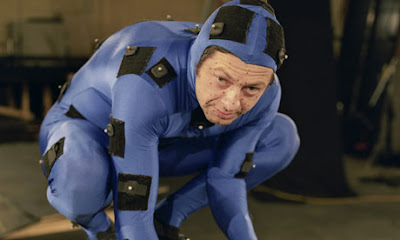The mocap suit:
Are you intrigued? Read more after the jump.
The beginnings of motion capture go all the way back to the 70's, but it has only recently become popular, largely because of The Lord of the Rings. To create the creature Gollum director Peter Jackson's team invented better and faster ways of using mocap. Originally, Gollum was going to be an animated character and Andy Serkis was only going to voice him. However, in order to make the Gollum voice, Serkis would distort his face and posture and Jackson realized that Serkis' physicality needed to be a huge part of Gollum's character. Instead of having Serkis just record Gollum's voice, Jackson had him perform on set with the other actors. To meet the technical needs of the visual effects team each scene was shot three times: First, the scene was shot with Serkis and the other actors, which was referred to as "animation reference."
Then the scene would be filmed without Serkis, which was called a "mime pass." In those takes the actors would perform the scene just as they had done the first time and Gollum would be added in later.
And finally, Andy Serkis would film the scene by himself in the mocap studio. The movements recorded in the studio would be translated into the digital version of Gollum, which was then fully animated.
This video shows two versions of Gollum's schizophrenia scene. On top is the footage of Andy on set and the bottom is the final version of the scene. As you can tell, Andy was SO good that the animators didn't need to change a thing about his performance. Even the tiny facial movements are the same. At some points Gollum even looks like Serkis.
In between these two steps Serkis filmed the same scene in a mocap studio, so his exact movements were translated into CG Gollum:
This method of creating motion-capture characters was groundbreaking. Soon motion-capture was popping up everywhere. The first movie that was filmed completely with motion-capture was The Polar Express (2004). Those markers on Tom Hanks' face are able to detect his small facial movements so the character will feel even more life-like.
Recently, director James Cameron took the science of motion-capture even further when he made Avatar (2009). Cameron and his team invented technology that could capture an actor's facial performance even more precisely. The actors wore a tiny mocap camera that was mounted on a special headpiece that was able to sense the trackers on their faces. Because the camera was so close to the actor's face it could pick up microscopic movements.
Andy Serkis spent almost 3 years playing Gollum. He achieved huge notoriety when the world learned exactly how Gollum was created. Because he is so experienced in using motion-capture, he is now Hollywood's go-to guy for motion-capture characters. After he played Gollum, Serkis worked on Peter Jackson's next film King Kong (2005). Can you guess who he played? That's right folks, he played King Kong. Jackson felt that Kong was another character that needed to be more than just animated. When you watch the movie you can tell that there is a human performance behind Kong.
Andy Serkis' most recent motion-capture character was Caesar, the genetically-enhanced chimpanzee in Rise of the Planet of the Apes, which came out a few weeks ago.
He also plays the part of Captain Haddock in The Adventures of Tintin, Steven Spielberg's latest film, which comes out in December.
Andy Serkis is now well-respected for his talent in creating motion-capture characters. I'm certain that he will continue to be called upon for mocap roles. He is so good, in fact, that people wanted him to be nominated for an Oscar for his role as Gollum. I'm not sure the film world is quite ready for that, but I think it will become more likely as the technology advances. The debate will probably reappear when Serkis reprises his role as Gollum in The Hobbit. Parts 1 & 2 are set to be released in 2012 and 2013.







No comments:
Post a Comment